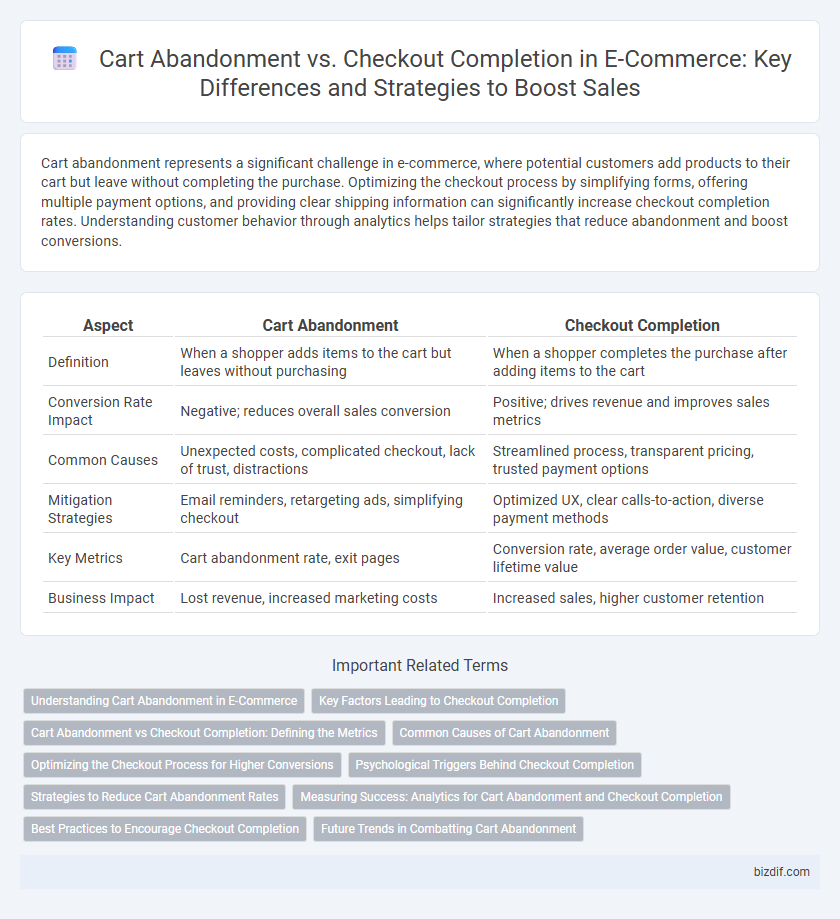Cart abandonment represents a significant challenge in e-commerce, where potential customers add products to their cart but leave without completing the purchase. Optimizing the checkout process by simplifying forms, offering multiple payment options, and providing clear shipping information can significantly increase checkout completion rates. Understanding customer behavior through analytics helps tailor strategies that reduce abandonment and boost conversions.
Table of Comparison
| Aspect | Cart Abandonment | Checkout Completion |
|---|---|---|
| Definition | When a shopper adds items to the cart but leaves without purchasing | When a shopper completes the purchase after adding items to the cart |
| Conversion Rate Impact | Negative; reduces overall sales conversion | Positive; drives revenue and improves sales metrics |
| Common Causes | Unexpected costs, complicated checkout, lack of trust, distractions | Streamlined process, transparent pricing, trusted payment options |
| Mitigation Strategies | Email reminders, retargeting ads, simplifying checkout | Optimized UX, clear calls-to-action, diverse payment methods |
| Key Metrics | Cart abandonment rate, exit pages | Conversion rate, average order value, customer lifetime value |
| Business Impact | Lost revenue, increased marketing costs | Increased sales, higher customer retention |
Understanding Cart Abandonment in E-Commerce
Cart abandonment in e-commerce occurs when shoppers add items to their online shopping cart but leave the site without completing the purchase, resulting in lost sales opportunities. Factors contributing to high cart abandonment rates include unexpected shipping costs, complicated checkout processes, lack of payment options, and concerns about security. Understanding these behaviors through analytics and user feedback enables businesses to optimize checkout experiences, reduce abandonment rates, and increase overall conversion.
Key Factors Leading to Checkout Completion
Streamlined user experience, transparent pricing, and multiple payment options significantly increase checkout completion rates in e-commerce. Offering guest checkout, clear shipping information, and trust signals like secure payment badges reduce cart abandonment. Personalized recommendations and optimized mobile interfaces further enhance customer confidence, leading to higher conversion rates.
Cart Abandonment vs Checkout Completion: Defining the Metrics
Cart abandonment rate measures the percentage of online shoppers who add items to their cart but leave without completing the purchase, typically ranging between 60% and 80% in e-commerce. Checkout completion rate quantifies the proportion of users who finalize their transactions after initiating the checkout process, serving as a critical indicator of conversion efficiency. Monitoring these metrics enables businesses to identify friction points in the purchase funnel and optimize user experience to increase sales revenue.
Common Causes of Cart Abandonment
High shipping costs, complicated checkout processes, and unexpected fees are primary causes of cart abandonment in e-commerce. Slow website load times and lack of multiple payment options also significantly contribute to customers leaving before completing purchases. Optimizing these factors can improve checkout completion rates and boost overall revenue.
Optimizing the Checkout Process for Higher Conversions
Reducing cart abandonment rates significantly boosts revenue by streamlining the checkout process with features like guest checkout, autofill forms, and multiple payment options. Clear progress indicators and minimal input requirements enhance user experience, encouraging customers to complete purchases. Integrating real-time error validation and trust signals such as security badges further increases checkout completion rates.
Psychological Triggers Behind Checkout Completion
Understanding psychological triggers such as urgency, social proof, and trust signals significantly improves checkout completion rates in e-commerce. Techniques like limited-time offers and customer testimonials leverage these triggers to reduce cart abandonment by enhancing perceived value and confidence. Optimizing the checkout process with clear progress indicators and secure payment options further decreases anxiety and motivates purchase finalization.
Strategies to Reduce Cart Abandonment Rates
Effective strategies to reduce cart abandonment rates include optimizing the checkout process by minimizing form fields and offering guest checkout options to expedite purchases. Implementing personalized retargeting emails and push notifications can remind customers of their pending carts and provide incentives like discounts or free shipping. Enhancing website performance with fast load times and mobile-friendly interfaces also significantly increases checkout completion rates.
Measuring Success: Analytics for Cart Abandonment and Checkout Completion
Analyzing cart abandonment rates alongside checkout completion metrics provides critical insights into customer behavior and potential friction points in the purchasing process. Leveraging tools like Google Analytics and heatmaps allows e-commerce businesses to identify drop-off stages and optimize user experience for higher conversion rates. Tracking these key performance indicators (KPIs) enables targeted strategies to reduce abandonment and boost successful transactions, directly impacting revenue growth.
Best Practices to Encourage Checkout Completion
Implement clear and persuasive calls-to-action paired with simplified, user-friendly checkout processes to reduce cart abandonment rates effectively. Employ personalized follow-up emails and retargeting ads that highlight saved cart items and offer limited-time discounts to motivate customers toward purchase completion. Optimizing mobile checkout interfaces and providing multiple payment options also significantly increase conversion rates by addressing common customer pain points.
Future Trends in Combatting Cart Abandonment
Emerging technologies like AI-driven personalized recommendations and predictive analytics are transforming strategies to reduce cart abandonment by anticipating user preferences and streamlining the checkout process. Integrating seamless payment solutions such as digital wallets and one-click purchasing significantly increases checkout completion rates by minimizing friction. Future trends also highlight augmented reality (AR) and chatbot integrations as critical tools for enhancing user engagement and support during the final purchase stages.
Cart Abandonment vs Checkout Completion Infographic

 bizdif.com
bizdif.com